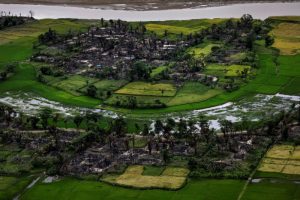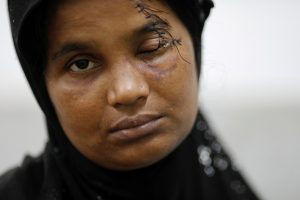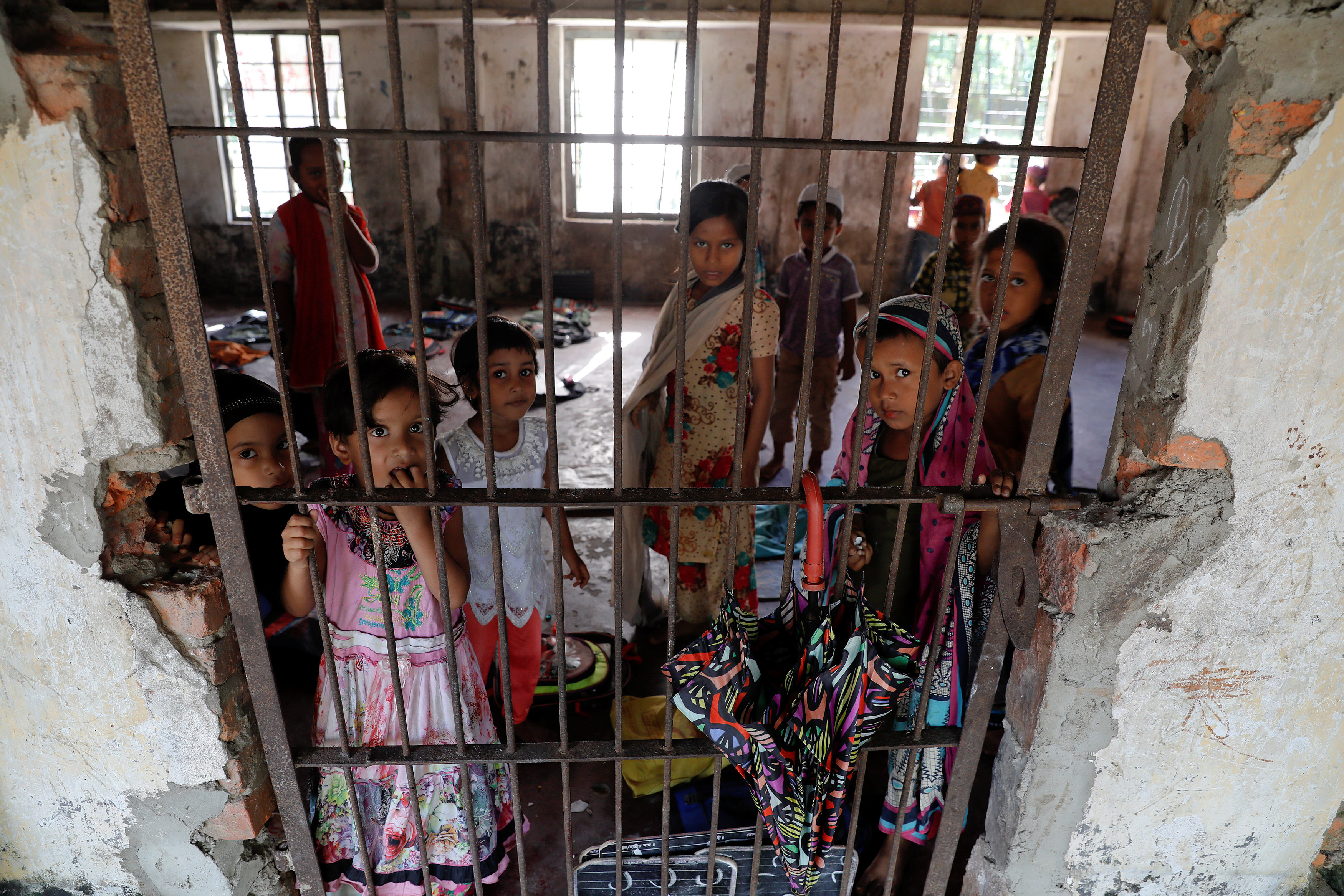
By Stephanie Nebehay
GENEVA (Reuters) – Myanmar’s military carried out mass killings and gang rapes of Muslim Rohingya with “genocidal intent” and the commander-in-chief and five generals should be prosecuted for the gravest crimes under international law, U.N. investigators said.
In a report, they called for the U.N. Security Council to set up an ad hoc tribunal to try suspects or refer them to the International Criminal Court in the Hague. The Security Council should also impose an arms embargo on Myanmar and targeted sanctions against individuals most responsible for crimes.
They blamed the country’s de facto civilian leader, Nobel Peace Prize winner Aung San Suu Kyi, for failing to use her “moral authority” to protect civilians. Her government “contributed to the commission of atrocity crimes” by letting hate speech thrive, destroying documents and failing to shield minorities from crimes against humanity and war crimes.
The report also criticised Facebook for allowing the world’s biggest social media network to be used to incite violence and hatred. Facebook responded on Monday by announcing that it was blocking 20 Myanmar officials and organizations found by the U.N. panel to have “committed or enabled serious human rights abuses”.
Contacted by phone, Myanmar military spokesman Major General Tun Tun Nyi said he could not immediately comment. The Myanmar government was sent an advance copy of the U.N. report in line with standard practice.
Zaw Htay, spokesman for Suu Kyi’s government, could not immediately be reached for comment. Reuters was also unable to contact the six generals named in the report.
A year ago, government troops led a brutal crackdown in Myanmar’s Rakhine state in response to attacks by the Arakan Rohingya Salvation Army (ARSA) on 30 Myanmar police posts and a military base. Some 700,000 Rohingya fled the crackdown and most are now living in refugee camps in neighboring Bangladesh.
The U.N. report said the military action, which included the torching of villages, was “grossly disproportionate to actual security threats”.
“The crimes in Rakhine State and the manner in which they were perpetrated are similar in nature, gravity, and scope to those that have allowed genocidal intent to be established in other contexts,” said the U.N. panel, known as the Independent International Fact-Finding Mission on Myanmar.
Suu Kyi’s government has rejected most allegations of atrocities made against the security forces by refugees. It has built transit centers for refugees to return, but U.N. aid agencies say it is not yet safe for them to do so.
MORAL AUTHORITY
Suu Kyi “has not used her de facto position as Head of Government, nor her moral authority, to stem or prevent the unfolding events, or seek alternative avenues to meet a responsibility to protect the civilian population”, the report said.
The United Nations defines genocide as acts meant to destroy a national, ethnic, racial or religious group in whole or in part. Such a designation is rare but has been used in countries including Bosnia, Rwanda, and Sudan.
In the final 20-page report, the panel said: “There is sufficient information to warrant the investigation and prosecution of senior officials in the Tatmadaw (army) chain of command so that a competent court can determine their liability for genocide in relation to the situation in Rakhine state.”
Marzuki Darusman, chair of the panel, said commander-in-chief Min Aung Hlaing should step down pending investigation.
“Accountability can only take place both from the point of view of the international community but also from the people of Myanmar if the single most significant factor is addressed. And that is the role of the commander-in-chief, Min Aung Hlaing.”
The list of generals also included Brigadier-General Aung Aung, commander of the 33rd Light Infantry Division, which oversaw operations in the coastal village of Inn Din where 10 Rohingya captive boys and men were killed.
That massacre was uncovered by two Reuters journalists – Wa Lone, 32, and Kyaw Soe Oo, 28 – who were arrested last December and are being tried on charges of violating Myanmar’s Official Secrets Act. The court had been due to deliver a verdict on Monday, but at a brief hearing postponed the hearings until Sept. 3.
In April, seven soldiers were sentenced to 10 years in prison for participating in the Inn Din killings.
Other generals named in the report included army deputy commander-in-chief Vice Senior-General Soe Win; the commander of the Bureau of Special Operations-3, Lieutenant-General Aung Kyaw Zaw; the commander of Western Regional Military Command, Major-General Maung Maung Soe; and the commander of 99th Light Infantry Division, Brigadier-General Than Oo.
Panel member Christopher Sidoti said “the clarity of the chain of command in Myanmar” meant the six generals must be prosecuted, even in the absence of a “smoking gun” piece of evidence to prove who had ordered the crimes.
“We do not have a copy of a direct order that says ‘undertake genocide tomorrow please’. But that is the case almost universally when cases of genocide have gone before the courts,” Sidoti said.
Darusman said a wider confidential list of suspects included civilians and insurgents as well as members of the military.

FILE PHOTO: The remains of a burned Rohingya village are seen in this aerial photograph near Maungdaw, north of Rakhine State, Myanmar September 27, 2017. REUTERS/Soe Zeya Tun/File Photo
“OPPRESSION FROM BIRTH TO DEATH”
The U.N. panel, set up last year, interviewed 875 victims and witnesses in Bangladesh and other countries and analyzed documents, videos, photographs and satellite images.
Decades of state-sponsored stigmatization against Rohingya had resulted in “institutionalized oppression from birth to death”, the report said.
The Rohingya, who regard themselves as native to Rakhine state, are widely considered as interlopers by Myanmar’s Buddhist majority and are denied citizenship.
“The Tatmadaw acts with complete impunity and has never been held accountable. Its standard response is to deny, dismiss and obstruct,” the U.N. report said.
Members of the panel had accused Facebook in March of allowing its platform to be used to incite violence. The report said the social media company should have acted quicker.
“Although improved in recent months, Facebook’s response has been slow and ineffective. The extent to which Facebook posts and messages have led to real-world discrimination and violence must be independently and thoroughly examined,” it said.
In a statement announcing its action on Monday, Facebook said it was removing 18 Facebook accounts, one Instagram account, and 52 Facebook pages.
“The ethnic violence in Myanmar has been truly horrific. Earlier this month, we shared an update on the steps we’re taking to prevent the spread of hate and misinformation on Facebook. While we were too slow to act, we’re now making progress – with better technology to identify hate speech, improved reporting tools, and more people to review content.”
Facebook had acknowledged in a statement issued 10 days ago following a Reuters investigative report into its failure to combat hate speech against the Rohingya and other Muslims in Myanmar that it had been “too slow” to address the problem.
(Reporting by Stephanie Nebehay; Editing by Adrian Croft)












